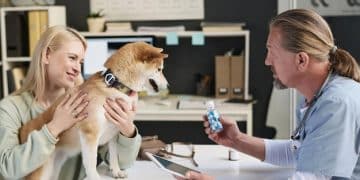Feline Hyperthyroidism: Latest Treatment Options and Success Rates in 2025

Feline hyperthyroidism, a common endocrine disorder in older cats, is characterized by an overproduction of thyroid hormones, leading to various clinical signs; modern treatment options include methimazole, radioactive iodine therapy, and surgery, each with varying success rates and considerations.
Feline hyperthyroidism can be a scary diagnosis, but understanding the latest treatment options is crucial for your cat’s well-being. This article delves into the current landscape of feline hyperthyroidism: understanding the latest treatment options and their success rates, offering insights and practical advice for cat owners navigating this condition.
Understanding Feline Hyperthyroidism
Feline hyperthyroidism is a common hormonal disorder, primarily affecting older cats. It stems from an overactive thyroid gland, which produces excessive amounts of thyroid hormones.
These hormones play a pivotal role in regulating metabolism, and when elevated, they trigger a cascade of physiological changes.
Recognizing the symptoms and understanding the underlying causes are the first steps in managing this condition effectively.
What Causes Feline Hyperthyroidism?
While the exact cause remains elusive, several factors are believed to contribute to feline hyperthyroidism. These include:
- Thyroid gland tumors: Benign tumors (adenomas) are the most common cause, leading to increased hormone production.
- Dietary factors: Possible links between certain commercial cat foods and hyperthyroidism are being investigated.
- Genetic predisposition: Some breeds may be more susceptible than others, suggesting a genetic component.
Common Symptoms to Watch For
The symptoms of feline hyperthyroidism can vary from subtle to severe. Being vigilant and recognizing these signs early is essential. Some of the most common symptoms include:
- Weight loss: Despite increased appetite, cats often lose weight.
- Increased appetite and thirst: Cats may exhibit voracious hunger and drink excessively.
- Hyperactivity and restlessness: Affected cats are often more agitated and restless than usual.
- Vomiting and diarrhea: Gastrointestinal upset can be a common symptom.

Understanding the symptoms and potential causes is essential for early detection and intervention. Early diagnosis allows for more effective management and improved quality of life for your feline companion.
Diagnosis of Feline Hyperthyroidism
Accurate diagnosis is crucial for initiating appropriate treatment for feline hyperthyroidism. Veterinary diagnostic procedures are designed to confirm the condition and rule out other potential health problems.
These processes involve a combination of physical examinations, blood tests, and, in some cases, advanced imaging techniques.
A comprehensive assessment is necessary to ensure that the diagnosis is precise, leading to a targeted and effective treatment plan.
Physical Examination and Palpation
The initial step in diagnosing feline hyperthyroidism typically involves a thorough physical examination by a veterinarian. During this exam, the vet will:
- Palpate the thyroid gland: Feeling the neck area to identify any enlargement or abnormalities in the thyroid gland.
- Assess heart rate and rhythm: Hyperthyroidism can cause an elevated heart rate or irregular rhythm.
- Evaluate overall health: Checking for other concurrent health issues that may influence treatment options.
Blood Tests and Thyroid Hormone Levels
Blood tests are essential for confirming a diagnosis of hyperthyroidism. Key tests include:
- Total T4 (thyroxine) level: Measures the total amount of T4, the primary thyroid hormone, in the blood. Elevated T4 levels are a strong indicator of hyperthyroidism.
- Free T4 (fT4) level: Measures the unbound, active form of T4. This test is more sensitive and less affected by other illnesses.
- TSH (thyroid-stimulating hormone) level: While not always reliable in cats, a low TSH level can support a diagnosis.
Additional Diagnostic Tools
In some cases, additional diagnostic tests may be necessary to rule out other conditions or further evaluate the thyroid gland:
Thyroid scintigraphy (nuclear scanning): This imaging technique uses a radioactive tracer to visualize the thyroid gland and identify abnormal tissue.
Prompt and accurate diagnosis is important for managing hyperthyroidism in cats. These diagnostic approaches enables veterinarians to develop tailored treatment strategies, maximizing the likelihood of a successful outcome.
Methimazole: An Overview of Medical Management
Methimazole is an antithyroid medication commonly used to manage feline hyperthyroidism. It works by inhibiting the production of thyroid hormones, thereby reducing their levels in the bloodstream.
This helps alleviate the symptoms associated with the disease and improves the cat’s overall health.
While methimazole is not a cure, it is an effective way to control hyperthyroidism and enhance the quality of life for affected cats.
How Methimazole Works
Methimazole functions by blocking the enzyme thyroid peroxidase, which is essential for the synthesis of thyroid hormones T3 and T4. By inhibiting this enzyme, methimazole reduces the amount of thyroid hormones produced by the thyroid gland.
Dosage and Administration
Methimazole is typically administered orally, either as a pill or a liquid. The dosage is determined by the veterinarian based on the cat’s individual needs and response to the medication. Regular monitoring of thyroid hormone levels is necessary to adjust the dosage as needed.
Potential Side Effects and Monitoring
While methimazole is generally safe, potential side effects can occur. It is important to be aware of these and monitor your cat closely. Common side effects include:
- Vomiting and diarrhea: Some cats may experience gastrointestinal upset.
- Lethargy: A decrease in energy levels may occur.
- Skin lesions: Rarely, skin irritation or lesions may develop.
Also, more serious but less common side effects include liver problems or blood disorders. Veterinarians often recommend routine blood tests to monitor liver function and blood cell counts.
Methimazole is a valuable tool in managing feline hyperthyroidism. While it requires diligent monitoring and may have potential side effects, it can significantly improve the quality of life for cats suffering from this condition.

Radioactive Iodine (I-131) Therapy: A Curative Option
Radioactive iodine (I-131) therapy is the treatment of choice for feline hyperthyroidism, offering a high success rate and the potential for a cure. This therapy involves administering radioactive iodine, which is selectively absorbed by the overactive thyroid cells.
The radiation destroys the abnormal tissue while sparing the rest of the body, effectively restoring normal thyroid function.
Although radioactive iodine therapy may require a period of hospitalization, it offers long-term benefits and eliminates the need for daily medication.
How I-131 Therapy Works
Radioactive iodine (I-131) is administered either orally or by injection. The iodine is absorbed into the bloodstream and concentrated in the thyroid gland. The radioactive emissions damage and destroy the overactive thyroid cells, reducing the production of thyroid hormones. In most cases, a single dose is sufficient to restore normal thyroid function.
The Treatment Process
The procedure typically involves the following steps:
- Initial assessment: A thorough evaluation, including blood tests and physical examination, is performed to confirm the diagnosis and assess overall health.
- Administration of I-131: The radioactive iodine is administered, usually through a single injection.
- Hospitalization: Cats must be hospitalized for several days to comply with radiation safety regulations. During this time, thyroid hormone levels are monitored.
Success Rates and Considerations
Radioactive iodine (I-131) therapy has a high success rate, with most cats achieving normal thyroid function after a single treatment. Success rates generally range from 95% to 98%. The treatment is safe and effective, the risks associated with anesthesia and surgery are avoided.
Radioactive iodine (I-131) therapy is a highly effective and curative option for feline hyperthyroidism. While it requires a short period of hospitalization, the long-term benefits and elimination of daily medication make it an excellent choice for many cats.
Surgical Thyroidectomy: When is it Recommended?
Surgical thyroidectomy, or the surgical removal of the thyroid gland, is an alternative treatment option for feline hyperthyroidism.
While it is less commonly performed than methimazole treatment or radioactive iodine treatment, surgery can be effective in certain circumstances.
Surgery may be recommended when other treatments are not feasible or when there are specific complications, such as a large thyroid tumor.
The Surgical Procedure
Thyroidectomy involves removing either one (unilateral thyroidectomy) or both (bilateral thyroidectomy) thyroid lobes. The surgical procedure typically includes the following steps:
- Anesthesia: The cat is placed under general anesthesia.
- Incision: An incision is made in the neck area to access the thyroid gland.
- Removal: The affected thyroid lobe(s) are carefully removed
- Closure: The incision is closed with sutures.
Risks and Potential Complications
While thyroidectomy can be effective, there are potential risks and complications associated with the procedure includes:
- Hypothyroidism: Removal of both thyroid lobes can lead to hypothyroidism, requiring thyroid hormone supplementation.
- Damage to the parathyroid glands: These glands regulate calcium levels; damage can lead to hypocalcemia.
- Recurrence: In some cases, hyperthyroidism can recur if not all affected tissue is removed.
Post-Operative Care and Monitoring
After surgery, the cat requires close monitoring for complications such as hypocalcemia or hypothyroidism. Pain management is crucial, and the incision site should be monitored for signs of infection.
Surgical thyroidectomy is a viable option for treating feline hyperthyroidism, but it should be carefully considered due to the potential risks and complications. Discussing the pros and cons of surgery with your veterinarian is essential to determine if it is the right choice for your cat.
Comparative Analysis: Success Rates and Considerations
When considering treatment options for feline hyperthyroidism, it’s important to analyze the success rates, advantages, and disadvantages of each approach.
The choice of treatment depends on various factors, including the cat’s overall health, the severity of the condition, the availability of treatment options, and the owner’s preferences and financial considerations.
A clear understanding of the comparative analysis can help facilitate informed decision-making and optimize the treatment outcome for your feline companion.
Methimazole
Methimazole is generally considered safe for long-term control of hyperthyroidism, it does not provide a cure.
The key pros and cons of methimazole include:
- Pros: Non-invasive, easy to administer, and relatively inexpensive
- Cons: Requires lifelong medication, may cause side effects, and does not cure the condition
Radioactive Iodine (I-131) Therapy
Radioactive iodine is often considered the gold standard treatment for feline hyperthyroidism due to its high success rate and curative potential. The primary benefits and drawbacks include:
- Pros: High success rate, often curative with a single treatment, avoids long-term medication.
- Cons: Requires hospitalization, may not be readily available in all areas, and can be more expensive than other options.
Surgical Thyroidectomy
Surgical thyroidectomy can be effective, but the specific benefits and disadvantages should be considered.
- Pros: Can be curative if performed correctly, eliminates the need for long-term medication, may be suitable for cats with large thyroid tumors.
- Cons: Requires anesthesia and surgery, potential risk of complications, and possibility of recurrence.
Selecting the right treatment requires careful consideration of multiple factors. By working closely with your veterinarian, you can determine the most suitable option for your cat, considering their individual needs and circumstances.
| Key Point | Brief Description |
|---|---|
| 🩺 Diagnosis | Involves physical exams and blood tests to check thyroid hormone levels. |
| 💊 Methimazole | An antithyroid medication used to control hormone production, requiring regular monitoring. |
| ☢️ Radioactive Iodine | A curative treatment involving a single dose and short hospitalization. |
| 🔪 Surgery | Surgical removal of the thyroid gland, an option when other treatments are not feasible. |
[Frequently Asked Questions]
▼
Feline hyperthyroidism is a common endocrine disorder in older cats, characterized by an overactive thyroid gland that produces excessive amounts of thyroid hormones, leading to increased metabolism and various clinical signs.
▼
Common symptoms include weight loss despite increased appetite, hyperactivity, increased thirst and urination, vomiting, diarrhea, and an unkempt appearance. Some cats may also exhibit an increased heart rate.
▼
Diagnosis typically involves a physical examination, palpation of the thyroid gland, and blood tests to measure thyroid hormone levels, specifically total T4 (thyroxine) and sometimes free T4 (fT4) to confirm the diagnosis.
▼
The main treatment options include medical management with methimazole, radioactive iodine therapy (I-131), and surgical thyroidectomy. Each option has its own benefits and considerations regarding efficacy and side effects.
▼
Radioactive iodine therapy has a high success rate (95-98%), often curative. Methimazole effectively controls symptoms but requires lifelong management. Surgical thyroidectomy may be curative but carries risks. Success varies depending on the method.
Conclusion
Understanding feline hyperthyroidism and its diverse treatment options empowers pet owners to make informed decisions in collaboration with their veterinarians. By considering the benefits, risks, and success rates of each approach, you can optimize your cat’s care and improve their overall quality of life, ensuring a happier, healthier future together.





